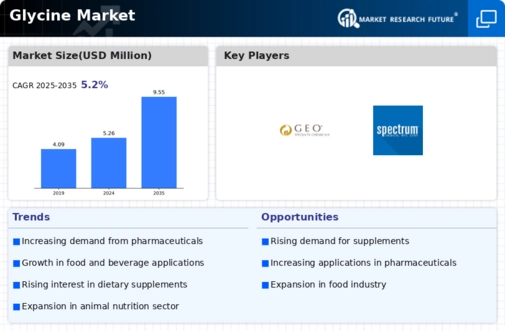Top Industry Leaders in the Glycine Market
 Glycine, the simplest amino acid, might seem unassuming, but its market is anything. The Glycine market is a dynamic universe bustling with diverse applications, from food and beverages to pharmaceuticals and chemicals. Players here navigate a complex space influenced by evolving trends, regulatory shifts, and technological advancements. Let's explore the strategies, factors, and recent developments shaping this multifaceted market.
Glycine, the simplest amino acid, might seem unassuming, but its market is anything. The Glycine market is a dynamic universe bustling with diverse applications, from food and beverages to pharmaceuticals and chemicals. Players here navigate a complex space influenced by evolving trends, regulatory shifts, and technological advancements. Let's explore the strategies, factors, and recent developments shaping this multifaceted market.
Strategies Fueling Glycine Growth:
-
Product Diversification: Leading players like Ajinomoto, Evonik, and Yuki Gosei Kogyo are constantly expanding their offerings, developing pharmaceutical-grade glycine for injectables, food-grade glycine for taste enhancement, and technical-grade glycine for industrial applications. -
Sustainability Focus: Environmental consciousness is gaining traction. Companies are adopting greener production processes, using recycled materials, and developing bio-based glycine alternatives to minimize environmental impact and cater to sustainability-driven customers. -
Vertical Integration: Securing reliable sources of key raw materials like soybeans and corn is crucial. Companies like Shandong Donghua Jinlong Chemical are investing in backward integration to gain control over the supply chain and optimize costs. -
Geographical Expansion: Emerging economies in Asia and Africa present immense potential, driven by rising disposable incomes and increasing demand for protein-rich food and pharmaceuticals. Companies like Hebei Donghua Jiheng Chemical are setting up production facilities and forging partnerships in these regions.
Factors Influencing Market Share:
-
End-User Industries: Food and beverages remain the primary drivers, consuming over 50% of global glycine production. Rising population, changing dietary habits, and the growing popularity of protein-fortified products contribute to this demand. -
Regulation and Safety: Stringent regulations on food additives, pharmaceutical ingredients, and chemical safety, like FDA in the US and REACH in Europe, drive the development of safe and compliant glycine grades. Companies meeting these standards gain a competitive edge. -
Technological Advancements: Research and development efforts are leading to novel manufacturing processes, improved purification techniques, and the development of glycine derivatives with targeted functionalities. Early adopters and innovators stand to benefit significantly from these advancements. -
Consumer Preferences: Growing demand for natural and organic ingredients fuels the adoption of bio-based glycine, while increasing health awareness drives demand for glycine-enriched food and supplements.
The key players of Glycine market are
- Ajinomoto North America, Inc
- Chattem Chemicals
- Phion Ltd
- Amino GmbH
- GEO Specialty Chemicals, Inc
- Yuki Gosei Kogyo Co., Ltd
- Merck KGaA
- Showa Denko KK
Recent Developments
-
September 2023: A breakthrough in bio-based glycine production using fermentation technology opens doors for a more sustainable future, attracting investments from eco-conscious players. -
October 2023: Ajinomoto unveils a new line of pharmaceutical-grade glycine with enhanced purity and solubility, targeting applications in injectables and oral medications. -
November 2023: A consortium of leading research institutions and food manufacturers launches a collaborative project to develop glycine-fortified food products for addressing malnutrition in developing countries. -
December 2023: The Glycine market shows signs of continued growth, driven by increasing demand, technological advancements, and a growing focus on sustainability. However, uncertainties in resource availability and potential regulatory changes require cautious optimism.










